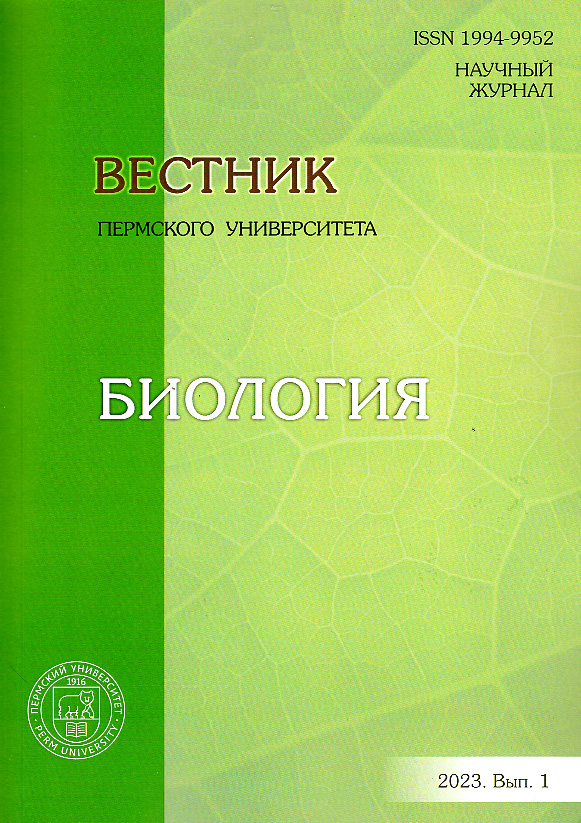Hormonal and bacterial regulation of innate lymphoid cells phenotypic changes in multiple sclerosis patients and healthy donors
Main Article Content
Abstract
Article Details
References
Некрасова И.В., Ширшев С.В. Женские половые стероидные гормоны в регуляции ферментативной активности нейтрофилов // Доклады Академии наук. 2013. Т. 453, № 6. С. 690–693.
Ширшев С.В., Некрасова И.В. Комплексное исследование иммуномодулирующей активности эстриола // Иммунология. 2011. Т. 32, № 2. С. 72–74.
Ширшев С.В. и др. Участие микроРНК в гормональных механизмах регуляции функций NK-клеток // Доклады Академии наук. 2017. Т. 474, № 1. С. 123–127.
Ширшев С.В. и др. Гормональная регуляция дифференцировки дендритных клеток тимуса // Бюллетень экспериментальной биологии и медицины. 2018. Т. 165, № 2. С. 193–197.
Bal S.M., Golebski K., Spits H. Plasticity of innate lymphoid cell subsets // Nature Reviews Immunology. 2020. Vol. 20, № 9. P. 552–565.
Cephus J.Y. et al. Estrogen receptor-α signaling increases allergen-induced IL-33 release and airway inflammation // Allergy. 2021 Vol. 76, № 1. P. 255–268.
Dolati S. et al. Multiple sclerosis: Therapeutic applications of advancing drug delivery systems // Biomedicine and Pharmacotherapy. 2017. Vol. 86. P. 343–353.
Ebbo M. et al. Innate lymphoid cells: major players in inflammatory diseases // Nature Reviews Immunology. 2017. Vol. 17, № 11. P. 665–678.
Elemam N.M., Hannawi S., Maghazachi A.A. Innate Lymphoid Cells (ILCs) as Mediators of Inflammation, Release of Cytokines and Lytic Molecules // Toxins. 2017. Vol. 9, № 12. P. 398.
Gharibi T. et al. Immunomodulatory characteristics of mesenchymal stem cells and their role in the treatment of multiple sclerosis // Cellular Immunology. 2015. Vol. 293, № 2. P. 113–121.
Grigg J.B. et al. Antigen-Presenting Innate Lymphoid Cells Orchestrate Neuroinflammation // Nature. 2021. Vol. 600, № 7890. P. 707–712.
Gury‐BenAri M. et al. The spectrum and regulatory landscape of intestinal innate lymphoid cells are shaped by the microbiome // Cell. 2016. Vol. 166, № 5. P. 1231–1246. e13.
Harbo H.F., Gold R., Tintore M. Sex and gender issues in multiple sclerosis // Archive of Therapeutic Advances in Neurological Disorders. 2013. Vol. 6, № 4. P. 237–248.
Hepworth M.R. et al. Immune tolerance. Group 3 innate lymphoid cells mediate intestinal selection of commensal bacteria-specific CD4⁺ T cells // Science. 2015. Vol. 348, № 6238. P. 1031–1035.
Jadidi-Niaragh F., Mirshafiey A. Th17 cell, the new player of neuroinflammatory process in multiple sclerosis // Scandinavian Journal of Immunology. 2011. Vol. 74, № 1. P. 1–13.
Kase N.G., Reyniak J.V. Endocrinology of pregnancy // Mount Sinai Journal of Medicine 1985. Vol. 52, № 1. P. 11–34.
McDonald W.I. et al. Recommended diagnostic criateria for multiple sclerosis: guidelines for the International Panel on diagnosis of multiple sclerosis // Annals of Neurology. 2001. Vol. 50, № 1. P. 121–127.
Moro K., Koyasu S. Innate lymphoid cells, possible interaction with microbiota // Seminars in Immunopathology. 2015. Vol. 37, № 1. P. 27–37.
Nekrasova I., Shirshev S. Estriol in regulation of cell-mediated immune reactions in multiple sclerosis // Journal of Neuroimmunology. 2020. Vol. 349(7). P. 577421.
Neill D.R. et al. Nuocytes represent a new innate effector leukocyte that mediates type-2 immunity // Nature. 2010. Vol. 464, № 7293. P. 1367–1370.
Neuteboom R.F. et al. Pregnancy in multiple sclerosis: clinical and self-report scales // Journal of Neurology. 2012. Vol. 259. P. 311–317.
Papenfuss T.L. et al. Estriol generates tolerogenic dendritic cells in vivo that protect against autoimmunity // Journal of Immunology. 2011. Vol. 186, № 6. P. 3346–3355.
Pelfrey C.M. et al. Effects of sex hormones on costimulatory molecule expression in multiple sclerosis // Journal of Neuroimmunology. 2005. Vol. 167, № 1–2. P. 190–203.
Russi A.E. et al. Male-Specific IL-33 Expression Regulates Sex-Dimorphic EAE Susceptibility // Proceedings of the National Academy of Sciences of the United States of America. 2018. Vol. 115, № 7. P. E1520–E1529.
Satoh-Takayama N. et al. Microbial flora drives interleukin 22 production in intestinal NKp46+ cells that provide innate mucosal immune defense // Immunity. 2008. Vol. 29, № 6. P. 958–970.
Sicotte N.L. et al. Treatment of multiple sclerosis with the pregnancy hormone estriol // Annals of Neurology. 2002. Vol. 52, № 4. P. 421–428.
Soldan S.S. et al. Immune modulation in multiple sclerosis patients treated with the pregnancy hormone estriol // Journal of Immunology. 2003. Vol. 171. P. 6267–6274.
Spits H. et al. Innate lymphoid cells–a proposal for uniform nomenclature // Nature Reviews Immunology. 2013. Vol. 13, № 2. P. 145–149.
Voskuhl R.R. et al. Estriol combined with glatiramer acetate for women with relapsing-remitting multiple sclerosis: a randomised, placebo-controlled, phase 2 trial // Lancet Neurology. 2016. Vol. 15, № 1. P. 35–46.




